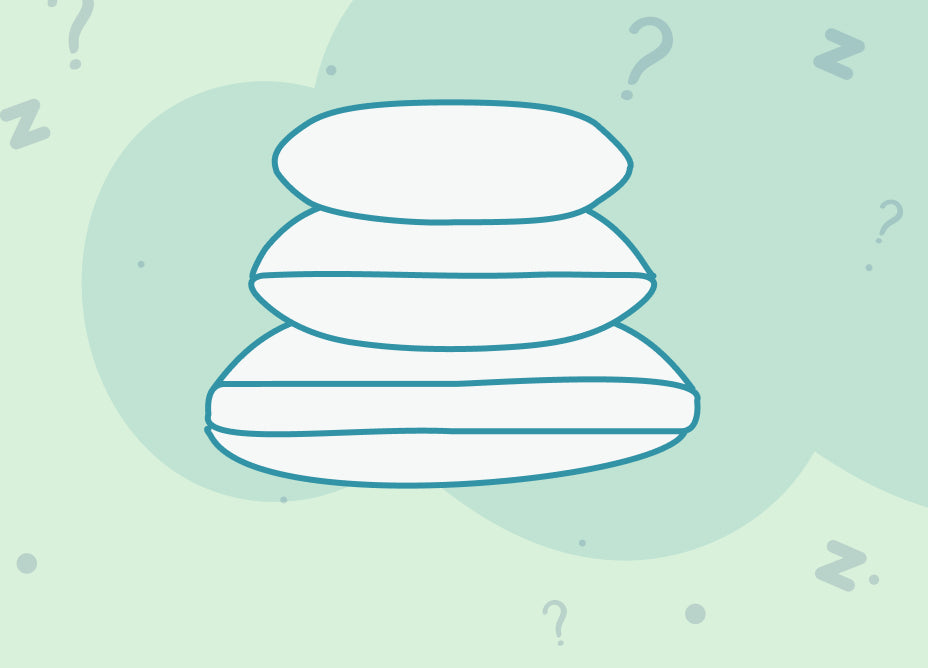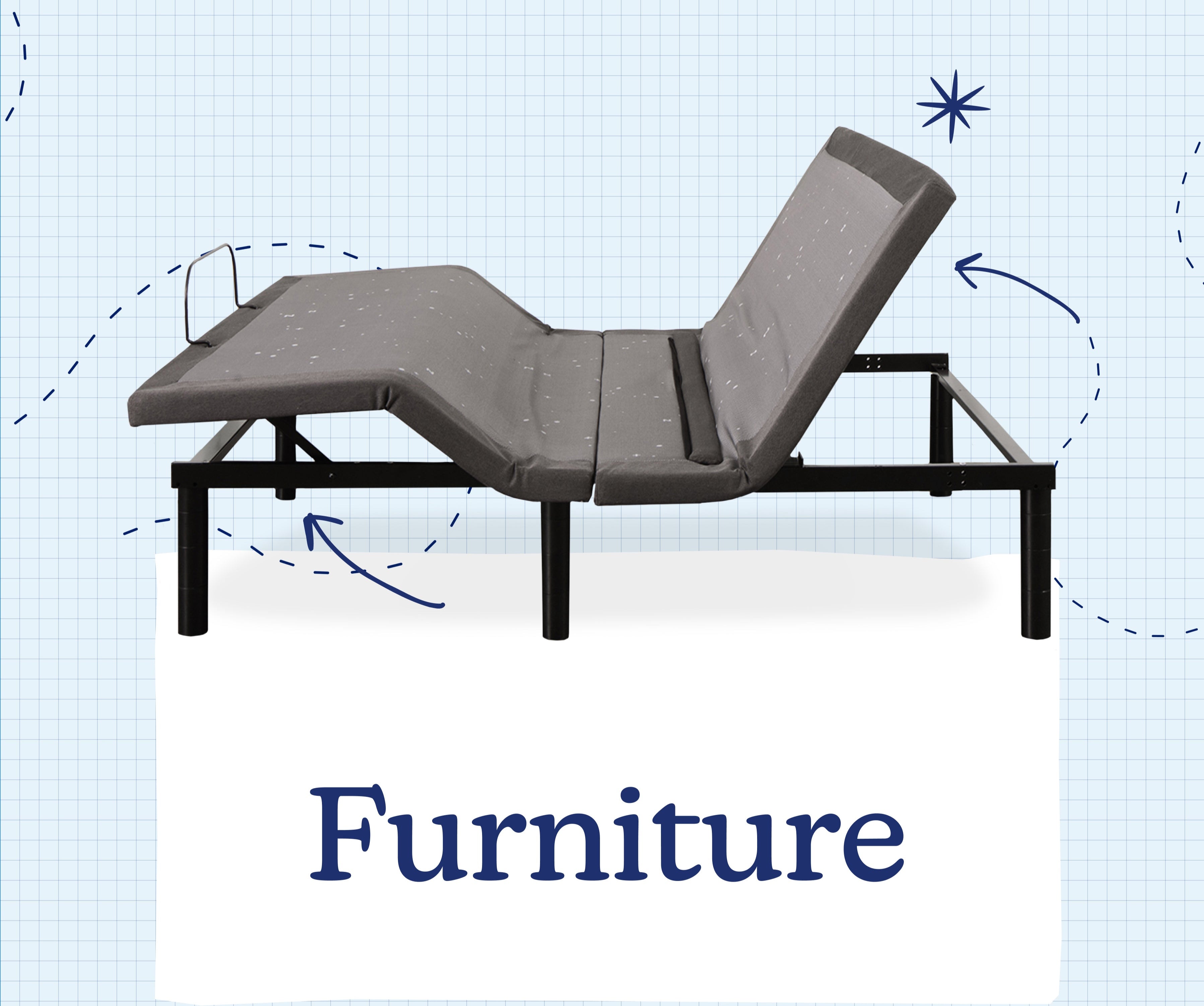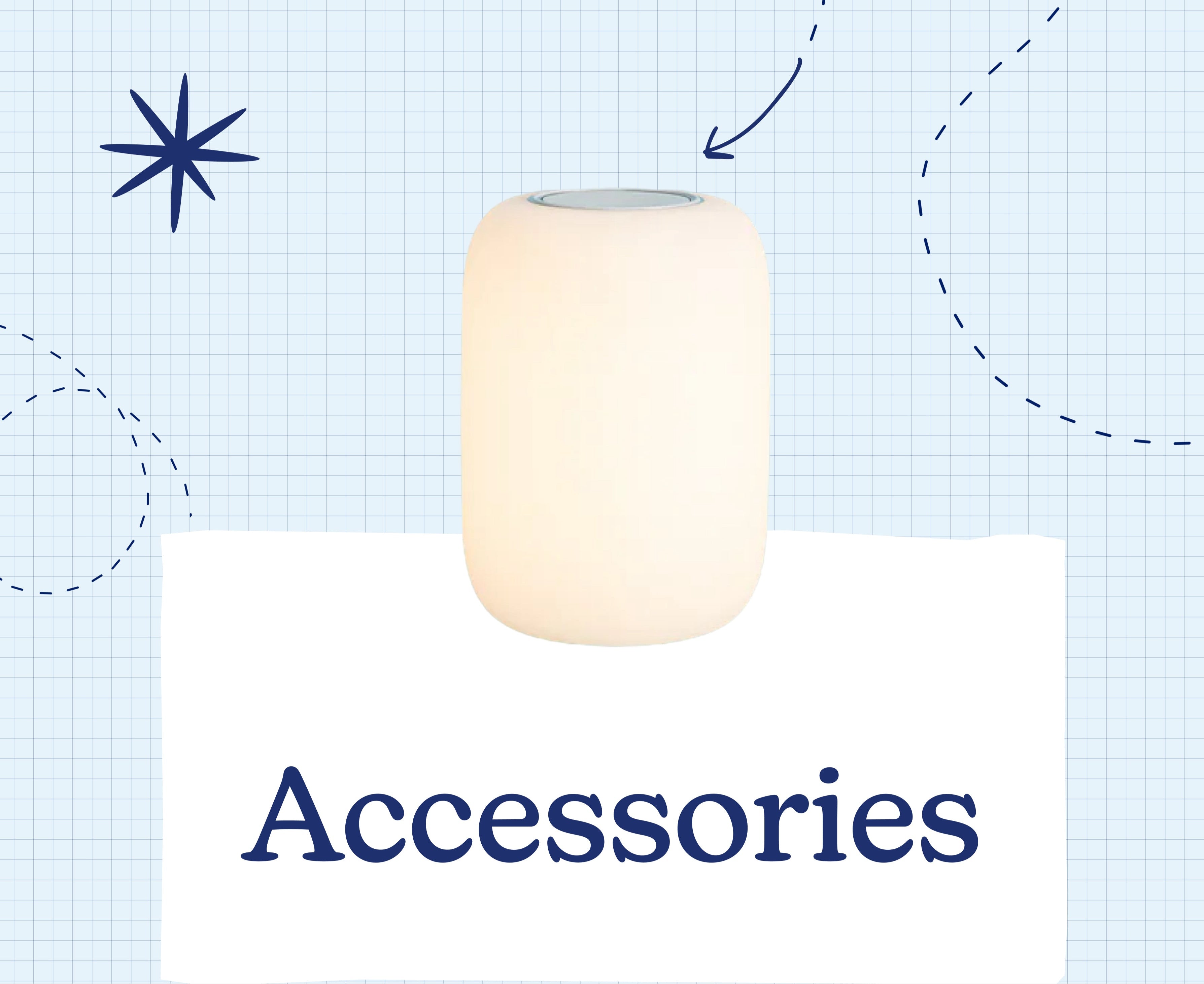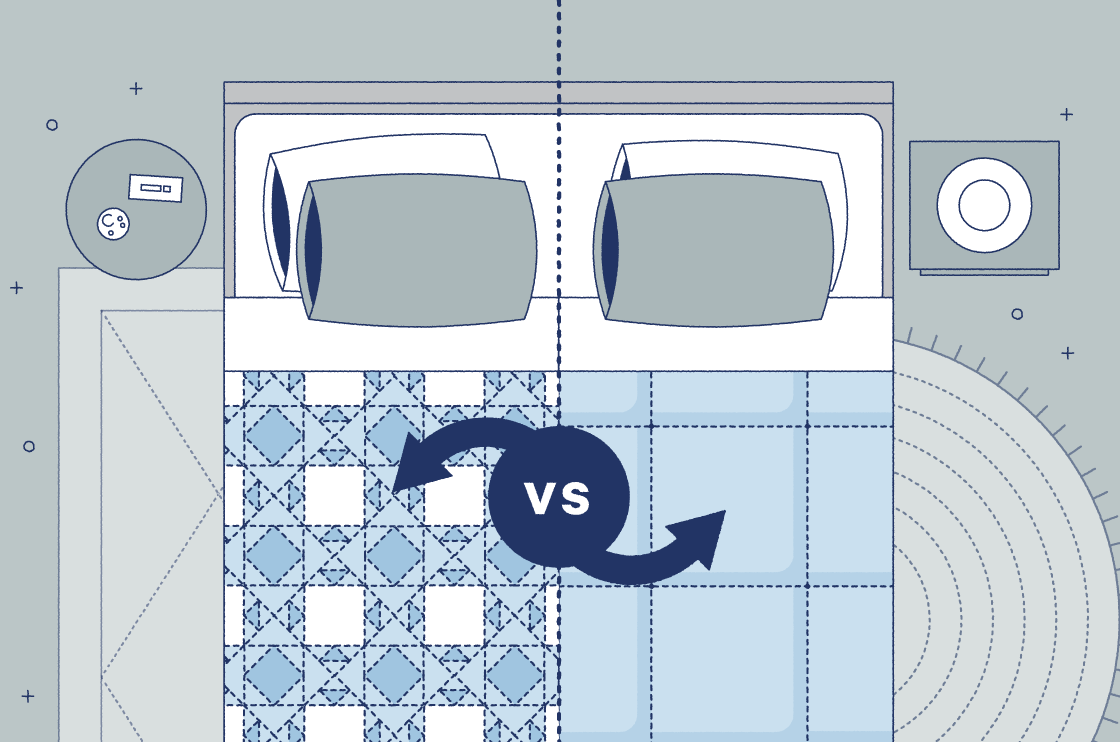Updated Aug 6, 2025
If you’re on the hunt for a new mattress, you might have realized you’ll need a box spring or foundation, too. The two often get confused, as a box spring falls within the mattress foundation category, but there are differences you need to know.
Box springs and solid foundations both provide an extra layer of support under your mattress. They add a little height while absorbing some of the weight, keeping your bed in peak condition
Box springs — though a little outdated — add more airflow and give. Foundations — made for most modern mattresses — are durable and provide firmer support.
But there’s a little more to it than that. Read on for our complete box spring vs. foundation guide to give your mattress the right support it needs. We promise, you’ll never confuse a box spring for a foundation again.
A Crucial Note for Casper Shoppers
Casper mattresses are not compatible with box springs. Placing any Casper mattress on a box spring will void the warranty because the springy surface can cause premature sagging and uneven wear. Stick to a solid or slatted foundation, adjustable base, or platform bed to keep your Casper covered and performing at its best.
What Is a Box Spring?

A box spring is a type of mattress foundation that is a wood or metal frame that includes coiled springs inside. It’s usually covered by cloth. The frame is similar to the size of your mattress, and the coils add some bounce and help absorb shock.
So, do you need a box spring? When most mattresses were designed with coils, box springs were essential. Nowadays, coil mattresses are going out of style in favor of options like memory foam and hybrid mattresses, which alleviate stress on pressure points, create better spinal alignment, and keep you cooler at night.
While different types of box springs still work well with traditional spring mattresses, they’re not as compatible with hybrids and more modern all-foam and latex ones.
Box Spring Pros and Cons
Though box springs might be phasing out, they still have their benefits. Here’s an overview of the pros and cons.
Pros:
- Adds bounce and give
- Provides good airflow and breathability
- Lightweight and easy to transport
Cons:
- Coils can break with wear and tear
- Over time, can start to sag
- Not compatible with hybrids, all-latex or memory foam mattresses
What Is a Foundation?

A foundation is a wood or metal bed base that sometimes includes slats lying across the top. This is also usually covered in fabric. The slats are spaced apart to provide air circulation and add strong structural support. A foundation makes for a durable, protective base for your mattress.
As memory foam and latex mattresses have risen in popularity compared to spring mattresses, so have foundations. Bed foundations have largely replaced box springs because they are compatible with modern mattresses, add better support, and last longer.
While there are many types of foundations out there, the Casper Mattress Foundation provides excellent support under any Casper mattress and can be assembled in minutes. Engineered with solid wood, the foundation has been rigorously tested for durability and proven to stand up to years of sleep.
Foundation Pros and Cons
Foundations might be compatible with more mattress types, but they aren’t without shortcomings. Here’s a look at the perks and drawbacks.
Pros:
- Compatible with most types of mattresses
- Built to be long-lasting
- Provides firm support
Cons:
- Less bounce and give
- May feel too firm for some
- Heavier and harder to transport
Difference Between a Box Spring and Foundation
Though box springs and foundations serve a similar purpose, they aren’t quite the same. Here’s an overview of the main differences.
| Box Spring | Foundation | |
|---|---|---|
| Construction | Frame with steel coils inside | Box with wooden slats across top |
| Cover | Fabric | Fabric |
| Support | More bounce and give | Firmer support |
| Durability | Less durable, coils can break | More durable, slats last longer |
| Breathability | More airflow | Less airflow |
| Compatible Mattresses | Innerspring | Innerspring, latex, memory foam, hybrid |
| Average Price of a Queen Size | Less expensive | More expensive |
Construction
A box spring is a wooden or metal bed frame containing steel coils. It’s usually covered in a breathable fabric.
A foundation, on the other hand, is a frame of any material with wooden panels, or slats, laid across the top. This is also usually covered with a light fabric.
Best option: Depends on preference
Support
Because it’s made of coils, a box spring allows for a little more give. That can be good for those who like bounce, but not the best for support. A foundation is designed for firmer support, so it wins out on this one.
Best option: Foundation
Durability
Over time, the coils in a box spring can break, leading to even less support. If coils are broken or old, you might also end up with a squeaky bed, which some may find annoying.
So, how long do box springs last compared to foundations? Mattress foundations are considered the more durable option. They have a strong construction that tends to last much longer than box springs.
Best option: Foundation
Breathability
Aside from the coils, a box spring is quite empty and light. That lends way to lots of airflow and breathability for your bed — great for those who sleep hot.
A foundation isn’t quite as lightweight as a box spring, but the evenly spaced slats and breathable fabric still allow it to stay cool.
Best option: Box spring
Weight
Because they're lighter, box springs are easier to move and handle. Foundations, on the other hand, are often denser and heavier because they use solid wooden panels or slats, making them sturdier but more cumbersome to transport and set up.
Best option: Box spring
Compatible Mattresses
Box springs were all the rage when most mattresses were produced with springs. Therefore, they’re compatible with traditional innerspring mattresses. Does a memory foam mattress need a box spring, though? In short, no — box springs do not do well with foam or latex mattresses. Those mattress types need something flatter and more solid to keep their support and prevent sagging.
Thankfully, a foundation is compatible with most mattress types, including innerspring, latex, memory foam, and hybrid mattresses. A foundation is designed to hold up just about any mattress and keep it firm for years.
Best option: Foundation
Average Price (Queen Size Reference)
The price of a box spring or foundation will vary depending on size, brand, and material. A box spring fitted to the size of a queen mattress will cost an average of $100 to $300. A queen-sized foundation is slightly pricier, costing anywhere from $200 to $500.
Best option: Box spring
Common Types of Bed Bases
Let’s delve deeper into the various types of bed mattress foundations beyond the standard box spring and unravel their unique characteristics and benefits.
Platform Beds: Sleek and Sturdy
Platform beds are the modern-day heroes of mattress support. With a sleek design and sturdy slats, they offer a solid base, making them compatible with a wide range of mattresses, including memory foam and hybrids. Plus, their elevated design opens up a world of under-the-bed storage opportunities, marrying functionality with style. Learn more about a platform bed vs box spring and explore the different types of platform beds for additional insight.
Adjustable Bases: Tailored Comfort
For those seeking personalized comfort, adjustable bed bases are a game-changer. With the ability to elevate the head and foot sections, an adjustable bed frame allows you to find your sweet spot for reading, watching TV, or alleviating health concerns like acid reflux and sleep apnea. It’s like bringing the luxury of a recliner to your bed!
Bunkie Boards: Slim Yet Supportive
Bunkie boards are the unsung heroes for those seeking a low-profile foundation. Typically one to three inches thick, these boards provide a solid, flat surface without adding much height, making them ideal for platform beds, daybeds, and bunk beds. Despite their slim design, bunkie boards offer proper support, especially for foam mattresses, ensuring stability and preventing sagging.
Shopping for Mattress Support Solutions
Now that you know the difference between box springs and foundations, it’s time to consider the best support for your bedtime combination. Below are some of our top picks to elevate your sleep experience.
Casper Haven Bed Frame
Wrapped in Felted Wool for softness all around, this cozy option brings a chic feel to the bedroom.
Casper Repose Bed Frame
This bed frame offers sleek support with softened edges to bring a warm look to any space.
Casper Adjustable Base Pro
A premium adjustable bed frame designed to enhance your sleep experience with a variety of customizable features. It aims to provide comfort and support for various activities beyond just sleeping, such as reading or watching TV in bed.
Find the Right Mattress for your Frame with Casper
Choosing the right mattress support is just as important as choosing the right mattress itself. At Casper, we offer a range of expertly designed mattresses and bed frames to ensure a restful and supportive sleep experience.
Explore our collection and discover the perfect match for your sleep needs today.
Box Spring vs Foundation FAQs
Is a Foundation the Same as a Box Spring?
No, a foundation and a box spring are not the same. While both provide support for your mattress, a box spring contains coils for a little extra bounce, whereas a foundation is made from solid wood or slats for firmer support. Foundations are also compatible with most modern mattresses like memory foam, while box springs are better suited for innerspring mattresses.
Again, Casper mattresses are not compatible with box springs, and using one with your Casper bed will void the warranty.
Can You Put Box Springs or Foundations on the Floor?
While you could place a traditional box spring on the ground, it’s not advisable. Most people choose to place them on top of a bed frame. This added height and support lets you get in and out of bed with ease. Plus, a bed frame adds storage space underneath the bed.
We don’t recommend putting the Casper Foundation directly on the floor, as it can wear away at the upholstery. Instead, an existing bed frame or platform base will seamlessly lift the foundation off the ground at an ideal height and keep it in good condition.
What Is the Standard Height of a Bed Base?
Ideally, a foundation should be between six and 12 inches . Combined with the bed frame and mattress, the whole bed comes out to be around two feet thick. We’ve found the best bed height to be around 25 inches, but it’s all a matter of personal preference.
The Casper foundation is seven and a half inches high, so it’s compatible with most beds out there.
Is a Box Spring or Foundation Necessary for a Mattress?
A bed base like a box spring or foundation adds crucial support for your bed. It can help keep your mattress in its best shape by preventing sagging and absorbing shock. Make sure you’re supporting your mattress with exactly what it needs. If you’ve decided to make the move from an old box spring bed foundation and coil mattress to a modern mattress and foundation, we’ve got you covered. Check out our award-winning foam mattresses, bed frames, and foundation to start snoozing better.











